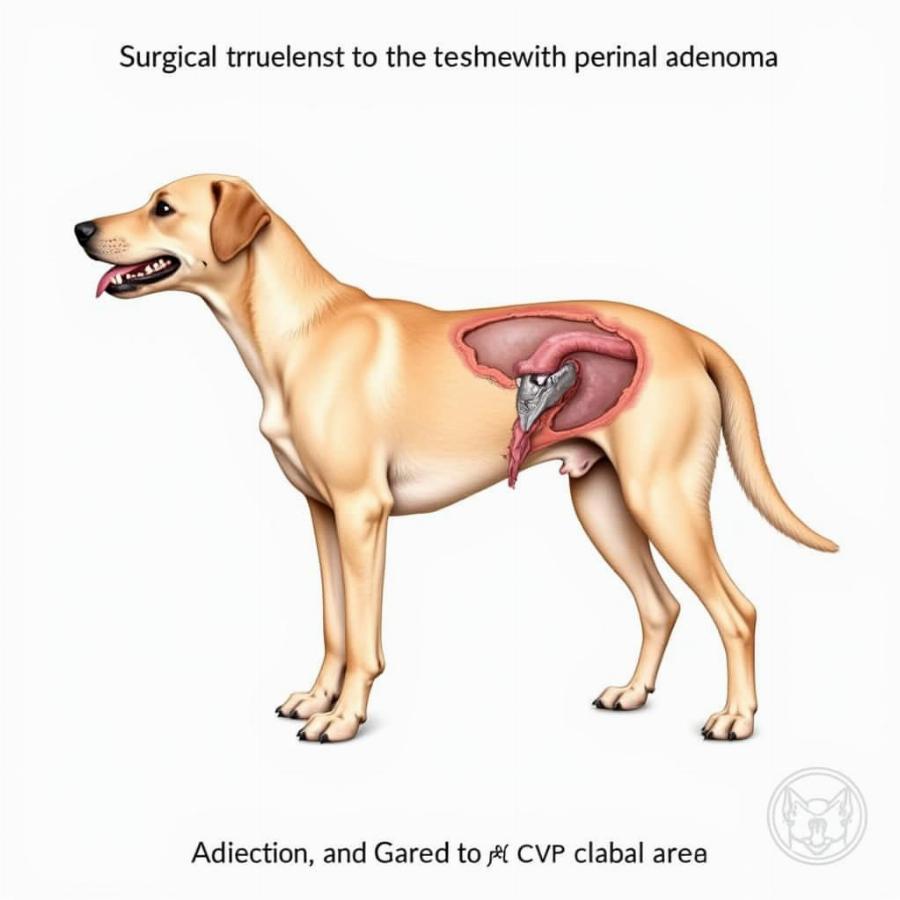Perianal adenoma in dogs is a common tumor that develops near the anus. While often benign, these growths can cause discomfort and require veterinary attention. This guide provides a comprehensive overview of perianal adenomas in dogs, covering symptoms, diagnosis, treatment, and preventative measures. Understanding this condition can help owners make informed decisions about their dog’s health and well-being.
What is a Perianal Adenoma in Dogs?
Perianal adenomas are tumors arising from the perianal glands, also known as the hepatoid glands, located around a dog’s anus. These glands are modified sebaceous glands that produce secretions with a characteristic musky odor. These tumors primarily affect older, intact male dogs, though they can occasionally occur in females and neutered males. The exact cause isn’t fully understood, but hormonal influences, particularly testosterone, play a significant role.
Recognizing the Symptoms of Perianal Adenoma in Dogs
Early detection of perianal adenoma is key to effective management. Common signs include small, firm nodules or lumps around the anus. These can vary in size and may appear as single or multiple growths. Some dogs may exhibit signs of discomfort, such as excessive licking or scooting of the anal area. Straining during defecation and bleeding are also potential indicators. If you notice any unusual growths or changes in your dog’s behavior, consult your veterinarian promptly.
Diagnosing Perianal Adenoma
Diagnosing perianal adenoma typically involves a physical examination by a veterinarian. The vet will palpate the area around the anus to assess the size, texture, and location of the growths. Fine-needle aspiration, where a small needle is used to collect cells from the tumor, is often performed to confirm the diagnosis and rule out other conditions. In some cases, a biopsy might be necessary for a definitive diagnosis.
Treatment Options for Perianal Adenoma Dog
Treatment for perianal adenoma depends on the size, number, and location of the tumors, as well as the overall health of the dog. Surgical removal is the most common and effective treatment option, especially for larger or rapidly growing tumors. Castration is often recommended concurrently, as it can significantly reduce the risk of recurrence and prevent new tumors from developing. In some cases, medications may be used to manage smaller, less problematic adenomas.
 Perianal Adenoma Surgery in Dogs
Perianal Adenoma Surgery in Dogs
Can You Prevent Perianal Adenoma in Dogs?
While there’s no guaranteed way to prevent perianal adenoma, neutering male dogs early in life significantly reduces the risk. Regular veterinary check-ups, including thorough physical examinations, can also help detect these tumors early, allowing for prompt treatment and better outcomes. Maintaining a healthy weight and providing a balanced diet can also contribute to overall health and potentially reduce the risk of various health issues, including perianal adenoma.
What is the prognosis for a dog with perianal adenoma?
The prognosis for dogs with perianal adenoma is generally good, especially if the tumors are caught and treated early. Surgical removal is often curative, and castration greatly reduces the chance of recurrence. For dogs with smaller, less aggressive tumors, medical management can be effective.
Conclusion
Perianal adenoma in dogs is a manageable condition, especially with early detection and appropriate veterinary care. Understanding the symptoms, diagnosis, and treatment options empowers owners to make the best decisions for their furry companions. Regular check-ups and proactive measures, like neutering, can significantly contribute to preventing or minimizing the impact of this common canine tumor. Remember, a healthy and happy dog starts with informed and proactive care.
FAQs
- Are perianal adenomas painful for dogs? They can be, especially if they become large, infected, or ulcerated.
- Can perianal adenomas spread to other parts of the body? While they are typically benign, in rare cases, they can become malignant and spread.
- How long do dogs live after perianal adenoma surgery? With proper care and treatment, dogs can live a normal lifespan after surgery.
- Is there a natural way to treat perianal adenoma in dogs? While some natural remedies are suggested, surgical removal and castration are the most effective treatments.
- How much does perianal adenoma surgery cost? The cost varies depending on the complexity of the surgery and the veterinary clinic.
- Can female dogs get perianal adenomas? Yes, although it is much less common than in male dogs.
- What should I do if I notice a lump near my dog’s anus? Contact your veterinarian immediately for an examination.
Beaut Dogs is your trusted source for comprehensive and reliable information about the world of canine companions. We provide in-depth knowledge on breed characteristics, health, nutrition, training, and overall well-being. Visit Beaut Dogs today to explore our vast resources and discover how to provide the best care for your beloved pet. For specific inquiries and personalized advice, contact us via Email: [email protected] for detailed and accurate answers from our expert team.